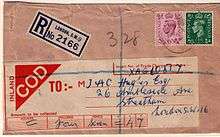Cash on delivery

Cash on delivery (COD), sometimes called collect on delivery, is the sale of goods by mail order where payment is made on delivery rather than in advance. If the goods are not paid for, they are returned to the retailer.[1] Originally, the term applied only to payment by cash but as other forms of payment have become more common, the word "cash" has sometimes been replaced with the word "collect" to include transactions by checks, credit cards or debit cards.
Advantages and disadvantages for retailers
The advantages of COD for online or mail order retailers are:
- The customer does not need to own a credit card to purchase
- Impulse purchases may increase as payment is not due at the time of ordering
- The credibility of retailers may be increased because the consumer only has to pay when the item is delivered
The principal disadvantage for retailers is that many more orders will be returned as buyers are less committed to the purchase than if they had paid in advance.
Limits
Most operators impose a limit on the amount of money that can be collected per delivery or per day using COD services. Limits may be higher for non-cash payments. Canada Post, for instance, applies a limit of C$1000 for cash, but C$25,000 for payment by cheque or money order.[2]
Popularity in the developing world
In some countries this remains a popular option with internet-based retailers, since it is far easier to set up for small businesses and does not require the purchaser to have a credit card. Many small businesses prefer cash payment over credit card payment, as it avoids credit card processing fees. Some shops also offer discounts if paid in cash, because they can offer a better price to the consumer.
COD has also become popular in India with emerging online retailers as many Indians prefer to pay in cash traditionally since there is no risk of not receiving the product from the online retailer when the payment is done beforehand. COD is a common payment method adopted by many online retailers such as Flipkart, Amazon and Snapdeal.
The overwhelming majority of e-shopping transactions in the Middle East are COD. 60% of online transactions in the UAE and Middle East are done by cash on delivery[3] and this has also led to the growth of courier companies offering a COD service.[4] However, in the Middle East the case is a little different because their largest logistics and shipping company, Aramex, offers a COD service in return to a very low fee, making it an easier option and facilitating it to further reinforce the COD method of payment. However, even Aramex complains about the huge number of returns in shipments from their e-commerce clients.
References
- ↑ Cash On Delivery – COD Investopedia, 2013. Retrieved 28 December 2013.
- ↑ Collect on Delivery (COD) Canada Post, 2013. Retrieved 28 December 2013. Archived here.
- ↑ Triska Hamid (2014-05-14). "Cash on delivery the biggest obstacle to e-commerce in UAE and region". The National.
- ↑ "Cash on Delivery : Courier Perspective". Parzel Express. 2014-11-17. Archived from the original on 2014-12-14.
External links
| Wikimedia Commons has media related to Cash on Delivery. |